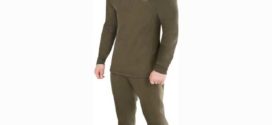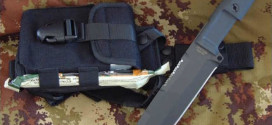A real survivalist needs a good knife. And that's it. Wherever you go and whatever you do, you will always need it. Most tourists, hunters and fishermen need a good, reliable knife, with which, when going out into the countryside, you can perform various types of work without any problems: from sharpening stakes and cutting branches to butchering game and gutting fish.
Of course, in the forest you can get by with an ordinary kitchen knife, but comparing this option with a real hunting knife is simply ridiculous. If your life is inextricably linked with tourism and hiking in the forest, then you should definitely get a good blade. In this article, you will learn what to look for when choosing a knife for hunting, hiking or fishing.
Content
Rules for choosing a great knife
We will not load you with such subtleties as steel grade and alloy structure. We will tell only about the main “chips” so that you can choose a high-quality and good knife that will serve you for many years and will never let you down.
What you should pay attention to:
1. Steel
Knives are made from various grades of steel, steel may have a different chemical composition and alloy structure. But as we have said, we will not focus on this. Let's just say that good enough hunting knives use 440C (110X18) steel. It sharpens quite easily and stays sharp for a long time. The hardness of such steel is 58-60 HRC, which is more than enough.
Given that a fisherman's or hunter's knife should cut well, but not saw, stab, and so on (there are other tools for these purposes), then you should focus on brands from 55 to 60 HRC. Below - too soft metal, which quickly blunts. This means that the cutting edge will have to be sharpened constantly. With blade brands over 60 of their own complexity. Such steel is characterized by hardness, and in the field its manual processing will be a big problem. In addition, the blade from it is not flexible, so it is easy (with excessive effort) to break, which is not uncommon in fishing or hunting.
Steel table (grade, chemical composition and hardness):
2. Handle
Form
The choice of this parameter is individual. Buying a knife just because it looks spectacular on the store counter (its showcase, in the brochure) is pointless. The handle of the knife should lie tightly in the hand, without causing inconvenience to the hunter or fisherman, no matter what movement he makes with the brush. In addition, few people take into account the fact that this tool has to be used all year round. Hunters conduct their trade mainly in the cold season, and there are many winter fishing enthusiasts among us.
Therefore, just holding the knife in your hand and making a couple of movements is not enough. Will it be convenient to use it if you have to wear gloves (mittens)? Will the palm move down from the hilt to the sharp blade? In this regard, it is desirable to focus on models with a limiter. Under no circumstances will he allow his hand to slip.
Handle material
Disputes on this issue, judging by the numerous reviews and comments on thematic sites, are endless. The author invites the reader to decide for himself which handle to choose, based on some properties and features of the materials.
Plastic. These knives are quite popular. The handle is not dirty, easy to clean, and has sufficient strength. There are only two disadvantages: at low temperatures there is a risk of cracks and chips; almost all types of plastics "do not like" contact with aggressive substances. How relevant is this for hunting and fishing? Wood. She needs to be constantly monitored. Firstly, it is easily damaged, and with careless handling, scratches or nicks cannot be avoided. Secondly, the handle of such a knife will have to be treated regularly with impregnations and varnish, otherwise it will gradually swell and deform. Bone. The high price (if it is not a fake) is the main disadvantage. For a fisherman, a hunter, the practicality of the knife and the ease of use of the tool are primarily important, and not whether the handle will cause admiration from the companions.They also sit comfortably in the hand and require little to no care, do not absorb dirt and odors, do not crack when wet, and do not change color. Although wood has its own plus - hands do not freeze, which cannot be said about the horn handle.
3. Scabbard
Briefly, they should have a special (usually plastic) insert. Otherwise, such scabbards are short-lived. They will be cut pretty quickly by the blade.
This is especially true if the sheath is made of leather. In the process of its tanning, substances are used that have a negative effect on steel. If the knife has been in such a “case” for a long time, then its blade will quickly become covered with dark spots, which are quite difficult, and sometimes impossible, to get rid of.
What not to choose:
- A knife with a hollow handle, which often has a built-in compass. Firstly, such a handle is not durable, and if it is also plastic, then it will not last long in winter, it has been verified. Secondly, such a handy device as a built-in compass is nothing more than a decoration, a “toy” for adults. No practical benefit. It is useless to navigate by it; it gives such errors that it is unlikely to find a way back.
- Knives with decorative notches on the handle. This is more suitable for gift options. That is, products that no one will use in the field. Various ribs, protrusions, spikes cause a lot of inconvenience, the hand gets tired quickly. Therefore, for a hunter and fisherman - not an option.
4. Purpose and design
Basically, difficulties arise if a folding knife is selected. The main difference between all models is in the type of lock connection. Without considering all the varieties, it is enough to note that for fishing or hunting, taking into account the specifics of the application, the best choice is the simplest mechanism. It is called a linear lock (liner-lock). It is a narrow spring-loaded steel plate recessed into the knife handle.
When choosing a model, you need to check:
- blade play. And in all directions (sideways, up);
- reliability of fixing the blade in the working position;
- how conveniently the knife folds / unfolds, whether the blade is skewed relative to the longitudinal axis of the handle.
Even a small “shat” of the blade (no matter how the seller assures otherwise) is a guarantee that the tool will soon have to be thrown away corny as unnecessary.
You should decide for what purposes you will most often use your knife. If you need a knife to butcher a carcass and skin a dead animal, then you need a hunting knife with a not very long blade - up to 16 cm, this is the most convenient option in this case. If you want to use it for chopping branches and firewood , then you need a heavier one. Although a camp hatchet is best suited for this.
Since our site is dedicated to survival, it is worth mentioning one more category - survival knives . This is the so-called universal option for all cases of extreme life. Such a knife can be used as a cutter, axe, machete or saw.
5. Design and shape
Regarding the shape of the blade, everyone has their own preferences. But if you think about the durability of the knife, then the best choice of profile is the so-called "wedge", and with a supply. Its peculiarity is that the working edge is sharpened at a slightly different angle. For a universal knife, its optimal value is 35 ± 50. With such a tool it is convenient to skin the beast, butcher the fish, and cut the bread.
Despite the variety, there are three main designs of hunting knives.
Drop Point
The main difference is a blade with a wide and thick blade, the cutting part of which is in the middle of the blade, and the blade is blunt in the upper part. The blade also has a rather sharp nose. With this knife it is very convenient to remove the skin and it is convenient to butcher large game.
Skinner
The blade of this knife is shorter than that of the drop point and strongly rounded, the blade does not have a sharp nose. The main purpose is to remove the skin from a dead animal. This is the so-called “skinning knife”.
clip point
Hunting knife for all occasions. It has a longer and narrower blade, it can also cut game, but its main task is domestic needs. If you are not a hunter, but just like to go hiking and often get out into nature, then this option is just right for you.
If you are engaged in tourism, then a universal survival knife will cope with almost any task, you can use it to open canned food, prepare chips for kindling a fire, and butcher the carcass of a dead animal.
Experienced people will tell you how to choose the right blade, and you will also see tests and reviews of some knife models:
What to consider when buying a knife
Any knife is not only a piercing and cutting tool. Many sold models (first of all, according to the length of the blade) can be recognized as melee weapons. Unfortunately, not all fishermen and hunters understand this when they choose the specimen they like. It is not in vain that the author recommends shopping only at specialized points of sale. And for this reason also.
To recognize a knife as a weapon, an expert opinion is required. This is clear. Some government officials, having seen an excellent (original, expensive, and so on) model from a fisherman or hunter, taking advantage of the fact that it is unlikely that anyone in nature will waste time and nerves proving the legality of wearing it, they simply take it away. Where, of course - yourself. And the owner waves his hand at this, since it is not yet known how everything will turn out if you start challenging the legality of such actions.
Therefore - when buying a knife for fishing or hunting, you need to ask the manager for a copy of the expert opinion on this model, moreover, also certified by the seal of the store. He has to give it up. And this document to have with you when going out into nature. Then there will definitely be no problems with representatives of the law regarding the wearing of a knife. Well, it is better to keep various “home-made products” (and there are many such among hunters and fishermen) away from prying eyes. Otherwise, there will be so many questions that adequate answers may not be found.
In principle, the main criteria for choosing a good knife for hunting or fishing are indicated. But it is unlikely that the article can be considered complete without giving a few examples. Social media users quite often mention the following knives, which in practice have proven their versatility and ease of use in any conditions.
Companion black
Made by Mora (Sweden). Distinctive features: a strong and sharp blade, high-quality fixation in the sheath (the color of which is fluorescent) and a handle made of rubber plastic. She is one of the main "chips" of the knife, as it is convenient to use it in any conditions, despite the season and the vagaries of the weather. It will never slip out of the palm of a hunter or fisherman, no matter what kind of work they do.
With such a knife, you can do a lot - clean the fish, butcher the carcass, cut bread and so on. Another significant plus of the tool should be noted - the length of the blade. It equals 10.5 cm. What does this mean, besides ease of use? Such a knife is not a melee weapon! This is what many hunters and fishermen forget about, choosing a model according to the principle “more is better”.
Price - from 830 rubles.
Opinel (No. 08)
According to users, this French folding knife is one of the most convenient.
Belongs to the class of fillets. Light weight, well balanced, sharply sharpened blade that does not need additional fine-tuning - an excellent choice for a fisherman or hunter. The length of the blade is 8 cm, therefore, the owner will not have problems with the law (related to registration) after acquiring such a knife.
The price is 1,445 rubles.
"Seal"
One of the budget domestic knives, which is great for fishing and hunting. Blades with a length of 10 cm, plastic handle and sheath, with a rubber coating.
Price - from 1980 rubles.
Hello, I am Alexander, the mastermind behind the blog.
In terms of career and free time, I connected my life with the forest. How else, when you live in Karelia! In this blog, I am responsible for the hunting, hiking and equipment sections. Welcome to my world!
 Survival Lessons Tips for the survivalist, fisherman and hunter
Survival Lessons Tips for the survivalist, fisherman and hunter






Thanks to the author for the article, he brought clarity to the chaotic knowledge about knives! The only moment - in the video, "the expert says," the girl, talking about knife handles, said "a wooden handle can dry out from contact with water" dry out from water?